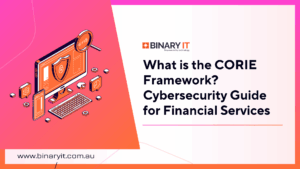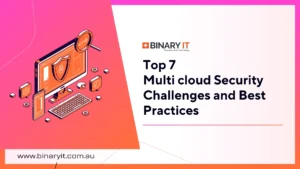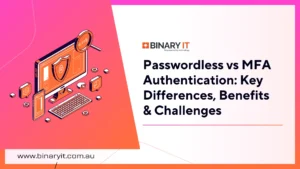Imagine answering the phone and hearing your bank’s familiar automated greeting, and later you learn you’ve fallen victim to a scam. This issue is becoming more common as scammers use advanced “vishing” techniques. In 2022, Australians lost over $3.1 billion to scams, with phone-based fraud accounting for a sizable chunk of this total. These digital con artists’ methods evolve in tandem with technological advancements.
The article explores into the world of vishing attacks, explaining how they operate, why people fall for them, and, most importantly, how you can defend yourself and your business from becoming the next victim. From AI-powered voice cloning to advanced social engineering tactics, we’ll provide you with the knowledge and tools you need to remain ahead of hackers as their methods evolve.
So, are you ready to defend yourself against the increasing number of voice phishing attacks?
What is Vishing?
Vishing, a combination of “voice” and “phishing,” is a form of social engineering attack conducted over the phone or voice communication systems. Vishing is also known as “voice phishing “. In a Vishing attack, cybercriminals use voice messages or live phone calls to manipulate victims into divulging sensitive information, transferring funds, or granting access to secure systems.
Like all phishing attacks, the primary goal of vishing is to exploit human psychology rather than technical vulnerabilities. Vishers often pose as legitimate entities, such as banks, government agencies, or tech support services, to gain the trust of their targets. By creating a false sense of urgency or authority, they pressure victims into making quick decisions that bypass normal security precautions.
Characteristics of Vishing
Typical vishing attacks share several key characteristics:
- Use of urgent or authoritative language
- Impersonation of legitimate entities (e.g., banks, government agencies, tech support)
- Creation of a false sense of urgency or fear
- Exploitation of human emotions and trust
What is the Purpose of Vishing?
Understanding the motivations behind unsolicited vishing attacks is important for developing effective defence strategies. Here are the primary purposes of vishing:
- Financial gain: The most common goal is to scam people out of their hard-earned money or get access to their financial accounts.
- Identity theft: Scammers frequently seek personal information in order to steal identities, create credit lines, or commit fraud in the victim’s name.
- Corporate espionage: In some circumstances, vishing is used to target organisations, attempting to get confidential company information or gain illegal access to networks.
- Malware installation: Some phishing scammers try to fool victims into downloading harmful software, which grants them remote access to devices or networks.
- Data harvesting: Scammers may collect personal information to sale it on the dark web or use it in future, more sophisticated attacks.
Don’t let your business fall prey to vishing attacks. Contact our cybersecurity experts to see how we can safeguard your data and secure your operations.
How Does Vishing Attack Work?
At its core, vishing relies on exploiting human psychology and trust. Attackers typically begin by gathering publicly available information about their targets through social media, company websites, or data breaches. With this knowledge, they craft convincing narratives to manipulate their victims.
The next step involves initiating contact, usually through a phone call or voicemail. Vishers often use VoIP services to mask their actual location and employ caller ID spoofing techniques to make their calls appear legitimate. During the conversation, the attacker uses various social engineering tactics to create a sense of urgency or fear, compelling the victim to act quickly without proper consideration.
How to spot a Vishing attack?
- Unexpected Calls: Be cautious if you receive calls from unknown numbers or unexpected sources, especially if they claim urgency.
- Urgent or Threatening Language: Scammers often use high-pressure tactics, insisting on immediate action or threatening consequences, to manipulate you into making quick decisions.
- Requests for Personal Information: Be wary of being asked to provide sensitive information over the phone, such as social security numbers, bank account numbers, or passwords.
- Unverifiable Caller Identity: Be suspicious if the caller claims to be from a reputable organisation but you can’t verify their identity.
- Too Good to Be True Offers: Promises of rewards, prizes, or money are common lures used in vishing attempts.
- Caller ID Spoofing: Scammers may manipulate caller ID to display a trusted number or name, making it appear legitimate.
- Lack of Professionalism: Be alert for poor grammar, unprofessional behaviour, or vague responses to your questions.
- Request for Immediate Payment or Action: Scammers may ask for immediate payment, often through unconventional methods like gift cards or wire transfers.
Related: How Scammers Use Emails to Target Individuals and Organisations
Why do People fall for Voice Scams?
Vishing exploits psychological factors like authority bias, where scammers impersonate trusted figures, and social proof, where they claim others have complied. These create a sense of normality and encourage compliance, making victims more likely to follow suit.
Common Methods and Scams Used in Vishing
Vishing scams come in many forms, but some are more prevalent in Australia than others. Here are some common vishing methods and scams to be aware of:
1. AI-based Vishing
Artificial intelligence has elevated vishing to a new level. Scammers are increasingly employing artificial intelligence-powered voice cloning technologies to mimic reputable individuals or organisations. These sophisticated computers can mimic voices with terrifying accuracy, making it increasingly impossible to tell the difference between legitimate and fraudulent calls.
For instance, an AI-generated voice might impersonate your bank manager, sounding similar to the real person. This technology allows scammers to create highly convincing and personalised vishing attacks, potentially fooling even the most cautious individuals.
2. Robocall
Robocalls are a constant irritant for many, bombarding individuals with automated messages and unsolicited pitches. Vishing schemes use automated systems to cast a wide net, reaching thousands of potential victims at the same time. The robocall usually consists of a pre-recorded message intended to evoke urgency or panic, pushing the recipient to dial a number to talk with a “representative.”
Once connected, the scammer takes over, often posing as a government official or bank employee. They might claim there’s an issue with your tax return or bank account, using the initial automated message as a hook to lend credibility to their scam.
3. VoIP
Scammers can now execute global vishing attacks using VoIP technologies. Visitors can use internet-based phone services to make calls that appear to originate in Australia, even if they are operating from another country.
This method allows scammers to bypass traditional telecom security measures and makes it more challenging for authorities to trace the source of fraudulent calls. Vishers might use VoIP to impersonate local businesses or government agencies, exploiting the trust associated with familiar area codes.
4. Dumpster Diving
While this method may seem low-tech compared to the others, it remains a popular tactic among vishers. Scammers physically rummage through rubbish bins to find discarded documents containing personal information. They then use this information to make their vishing calls more convincing.
A scammer may phone, pretending to be from your retirement fund, armed with information acquired from a discarded statement. This level of personalisation might take victims off guard, increasing the likelihood that they would fall for the fraud.
5. Caller ID Spoofing
This technique involves manipulating the caller ID information that appears on your phone. Scammers can make their calls appear to come from legitimate sources, such as your bank, the Australian Taxation Office, or even your own phone number.
For example, you might receive a call that displays the official phone number of your bank. The scammer on the other end then claims to be from the bank’s fraud department, using the seemingly legitimate caller ID to build trust and extract sensitive information.
6. Tech Support Call
This classic type of scam continues to evolve and remains prevalent in Australia. Scammers pose as tech support representatives from well-known companies like Microsoft or Apple, claiming that they’ve detected a problem with your computer. They then trick you into adding your personal information to gain access to their personal information.
The visher might use technical jargon to confuse and intimidate, insisting that immediate action is needed to prevent data loss or system damage. They often request remote access to your computer, which can lead to malware installation or the theft of sensitive information.
Don’t wait for a real phishing attack to test your defences. Contact us to schedule a phishing attack simulation and strengthen your organisation’s cybersecurity today.
Impact of Vishing
The consequences of falling victim to a vishing attack can be severe and far-reaching:
Financial Losses
Vishing can lead to direct monetary losses for individuals and businesses. Victims may unknowingly transfer funds to fraudulent accounts or provide credit card information that is then used for unauthorised purchases.
Personal Information Theft
Attackers often seek sensitive personal data such as Social Security numbers, bank account details, or login credentials. This information can be used for identity theft or further exploitation.
Reputation Damage
For businesses, a successful vishing attack can result in significant reputational damage, eroding customer trust and potentially leading to long-term financial repercussions.
Detection and Prevention of Vishing
Protecting yourself and your organisation from vishing attacks requires a multi-faceted approach. Here are some key strategies for detection and prevention:
- Implement caller ID verification: Use technology that can detect spoofed numbers and warn of potential scam calls.
- Educate employees: Conduct regular cybersecurity training sessions on vishing awareness and best practices for handling suspicious calls.
- Establish clear protocols: Develop and enforce strict procedures for verifying caller identities and handling sensitive information requests.
- Use multi-factor authentication: Implement multi-factor authentication for additional security measures beyond just passwords for accessing sensitive accounts or information.
- Regularly update security systems: Keep all software, firewalls, and anti-malware programs up-to-date to protect against the latest threats.
- Monitor accounts closely: Regularly audit financial statements and credit reports for any suspicious activity.
- Leverage voice biometrics: Consider implementing voice recognition technology to authenticate legitimate callers.
- Encourage a culture of scepticism: Promoting a mindset where individuals feel comfortable verifying the legitimacy of unsolicited communications and scrutinising unusual requests.
Don’t risk your organisation’s security. Contact our cybersecurity professionals at Binary IT to explore how we can safeguard your operations from cyber attacks.
What’s the Difference Between Vishing, Phishing and Smishing?
While these three scam techniques share the common goal of deceiving victims to obtain sensitive information, they differ in their delivery methods:
- Phishing:
- Primarily uses email or fake websites.
- Attempts to trick victims into clicking malicious links or downloading attachments.
- Can target a large number of potential victims simultaneously.
- Vishing (Voice Phishing):
- Uses voice communication, typically phone calls.
- Exploits the personal nature of verbal interactions.
- Often involves caller ID spoofing and social engineering tactics.
- Smishing (SMS Phishing):
- Utilises text messages (SMS) to deceive victims.
- Often contains links to malicious websites or prompts to call a fraudulent number.
- Exploits the immediacy and high open rates of text messages.
Real-Life Vishing Examples
AI-powered Vishing Scam:
In 2021, a significant cyberattack occurred, where attacker used AI-powered voice cloning to impersonate a company director. The attacker convinced a bank manager via phone call to authorise a $35 million transfer, claiming it was for an acquisition process.
Hollywood Con Queen Scam:
Starting in 2015, a phishing scammer posed as Hollywood makeup artists and influential female executives to lure victims into travelling to Indonesia and paying money, falsely promising reimbursement. The scammer utilised social engineering techniques, meticulously researching their victims’ lives to create convincing impersonations. They called the victims directly, often multiple times a day and for extended periods, to apply pressure.
UK Energy Firm Vishing Attack (2019)
In 2019, a UK-based energy firm’s CEO was tricked into transferring €220,000 (about $243,000) to a Hungarian supplier. The scammer used AI voice technology to impersonate the German chief executive of the firm’s parent company, convincing the CEO that the transfer was urgent. This incident, while not a traditional website spoofing case, demonstrated the evolving nature of spoofing attacks and the increasing use of sophisticated technologies like AI in cybercrime.
Covid-19 Scam
On March 28, 2021, the Federal Communications Commission (FCC) alerted about an increasing number of phone scams involving fraudulent COVID-19 products. These voice phishing schemes, monitored by the Food and Drug Administration (FDA), have targeted consumers by falsely claiming to offer products that can “prevent, treat, mitigate, diagnose, or cure” COVID-19.
Future Trends in Vishing
As vishing techniques continue to evolve, we need to stay ahead with stronger defences. Looking forward, here are a few promising developments that could shape the future of voice security:
Biometric voice authentication systems are becoming increasingly sophisticated, offering a more secure method of verifying caller identities. These systems analyse unique vocal characteristics to create a “voiceprint” that can be used to authenticate legitimate callers and flag potential imposters.
Additionally, blockchain technology is being explored as a potential solution for securing voice communications and preventing spoofing. By creating an immutable record of call origins and routeing information, blockchain could provide a transparent and tamper-proof system for validating caller identities.
Conclusion
Vishing poses a significant threat to Australians, but with the right knowledge and tools, we can protect ourselves and our businesses. By understanding the mechanics of these attacks, recognising the warning signs, and implementing robust defence strategies, we can significantly reduce our vulnerability to voice phishing scams.
Remember, your financial security and personal information are worth more than any urgent request or tempting offer. The next time your phone rings, pause and ask yourself: Is this call truly what it seems? Your moment of hesitation could be the difference between security and regret.
Protect Yourself and Your Business Today
Don’t let vishing scammers catch you off guard. Arm yourself with knowledge and take action to safeguard your personal and financial information. Our cybersecurity experts are ready to help you build a robust defence against vishing attacks. Reach out to us for expert cybersecurity support and solutions.





